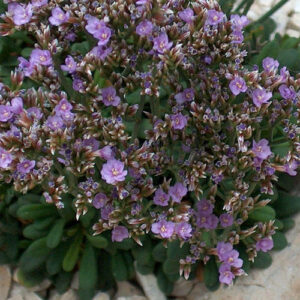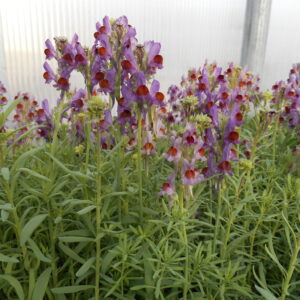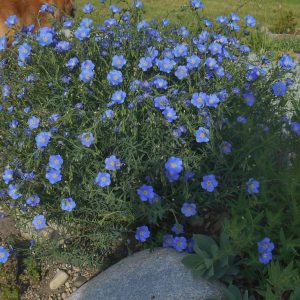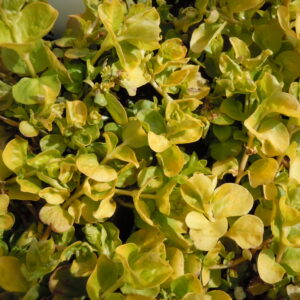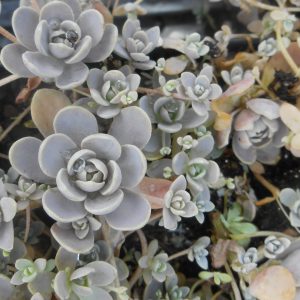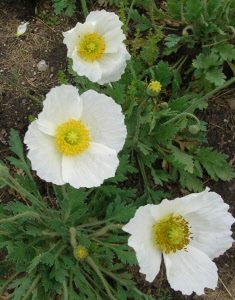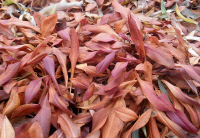Alpine, Rock, Miniature, Bonsai and Railroad Gardens
Showing 57–64 of 92 results
-
Limonium minutum Dwarf statice Z 5-9
All summer long, droves of lavender blossoms above a mini pillow of spoon-shaped, glossy foliage.
OUT OF STOCK
All summer long, droves of lavender blossoms above a mini pillow of spoon-shaped, glossy foliage.
Size: 6-8” x 6-8”
Care: sun in well-drained soil
Native: southeast France on limestone seacliffs
Wildlife Value: deer resistant, salt tolerantDescribed by Linnaeus, 1753. The name Limoniuim comes from the Greek word for meadow.
-
Linaria alpina Alpine toadflax Z 5-8
Purple snapdragon-like petals bloom all summer and show off golden-orange lips
OUT OF STOCK
Purple snapdragon-like petals bloom all summer and show off golden-orange lips
Size: 4-6” x 6-12”
Care: sun in well-drained soil
Native: Mountains of central and southern EuropeListed in Gardeners Dictionary, 1768. Wm Robinson in July 1872 issue of The Garden: “The alpine Linaria is never more beautiful than when self-sown in a gravel walk.” January 1876 bloomed for 4+ months in the rock garden at Edinburgh Botanic Garden.
-
Linum alpinum Alpine flax, Mountain flax Z 4-9
Compact blue flax, perfect for the rock garden or in a sunny border. Bushy mound of small soft-blue saucers for weeks in late spring & early summer. Reblooms if you cut it half way back in late June
Compact blue flax, perfect for the rock garden or in a sunny border. Bushy mound of small soft-blue saucers for weeks in late spring & early summer. Reblooms if you cut it half way back in late June
Size: 8-12” x 10-12”
Care: sun in well-drained soil
Native: mountains of EuropePublished as a separate species in 1925.
-
Lysimachia nummularia ‘Aurea’ Creeping jenny Z 3-9
Bright yellow flowers in summer, chartreuse foliage
Bright yellow flowers in summer & chartreuse foliage which is the reason to grow this. Chartreuse is the little black dress, it goes with everything.
Size: 2” x spreading
Care: full sun to part shade in moist to moist well-drained soil
Native: Europe
Awards: England’s Royal Horticultural Society Award of Garden Merit.Dioscorides (1st century A.D.) named Lysimachia after King Lysimachus of Thracia. By the 1590’s used as cure for wounds and whooping cough. Species listed in Gardeners Dictionary, 1768. ‘Aurea’, H.H. Thomas 1915. Breck (1851) called this “suitable for rockwork or hanging from a pot in a northern exposure.” L.H. Bailey echoed this: “Very useful for rustic vases and baskets, also for carpeting ground in shady places.”
-
Melampodium leucanthum Blackfoot daisy Z 5-10
No fail low mounds of up to 50 small white daisies spring-fall, atop narrow, hairy, grey-green leaves
OUT OF STOCK
No fail low mounds of up to 50 small white daisies spring-fall, atop narrow, hairy, grey-green leaves
Size: 6-10” x 12-20”
Care: sun to part-shade in well-drained soil. Its tap root reaches down for moisture and hair on foliage protects if from desiccating winds and sun - xeric plant
Native: Colorado, Oklahoma, TX &AZ (no wonder it likes well drained soil) but perfectly happy as far north as 20° below zero in winter.
Wildlife Value: birds eat seeds –pollen and nectar attract bees and butterflies. Deer resistantBotany professor John Riddell found this in Texas, Described in Flora of North America, 1842.
-
Orostachys iwarenge Chinese dunce cap In China called wa song shu Z 5-10
Three-in-one: starts as fleshy silver-blue rosettes spreading to 12” across, then pyramids (dunce caps) of foliage & finally pink & white frilly flower spikes in October. Mother plant dies after flowering but its offsets survive (like Hens & chicks) plus it reseeds for more plants next season.
OUT OF STOCK
Three-in-one: starts as fleshy silver-blue rosettes spreading to 12” across, then pyramids (dunce caps) of foliage & finally pink & white frilly flower spikes in October. Mother plant dies after flowering but its offsets survive (like Hens & chicks) plus it reseeds for more plants next season.
Size: 6” x 14”
Care: sun to part shade in moist well-drained to well-drained soil
Native: China1st described in Western literature in 1878. Renamed several times – Cotyledon malacophylla var. japonica (1878), Cotyledon iwarenge, Sedum iwarenge.
-
Papaver anomalum alba Z 5-9
Paper-thin petals on this pure white poppy
Paper-thin petals on this pure white poppy wth yellow stamens blooms all summer and fall – June to October, and November if it’s mild. Absolutely one of our favorites.
Size: 12” x 8”
Care: sun to part shade in moist well-drained to well-drained soil. Deer resistant
Native: European AlpsCollected by 1909.
-
Persicaria affinis syn. Bistorta affinis Dwarf fleeceflower, Himalayan Knotweed Z 4-9
A spreading, mat-forming perennial bearing pink to red flower spikes, blooming late summer and autumn. Foliage turns red in autumn and winter. Good groundcover
A spreading, mat-forming perennial bearing pink to red flower spikes, blooming late summer and autumn. Foliage turns red in autumn and winter. Good groundcover,
Size: 8-12” x 3’ spreading
Care: sun to part shade in moist well-drained soil
Native: high mountains of Nepal in rocky areas and open slopesCollected by plant hunter Nathaniel Wallich (1786-1854) and described by botanist David Don (1799-1841) in Prodromus Florae Nepalensis in 1825.

